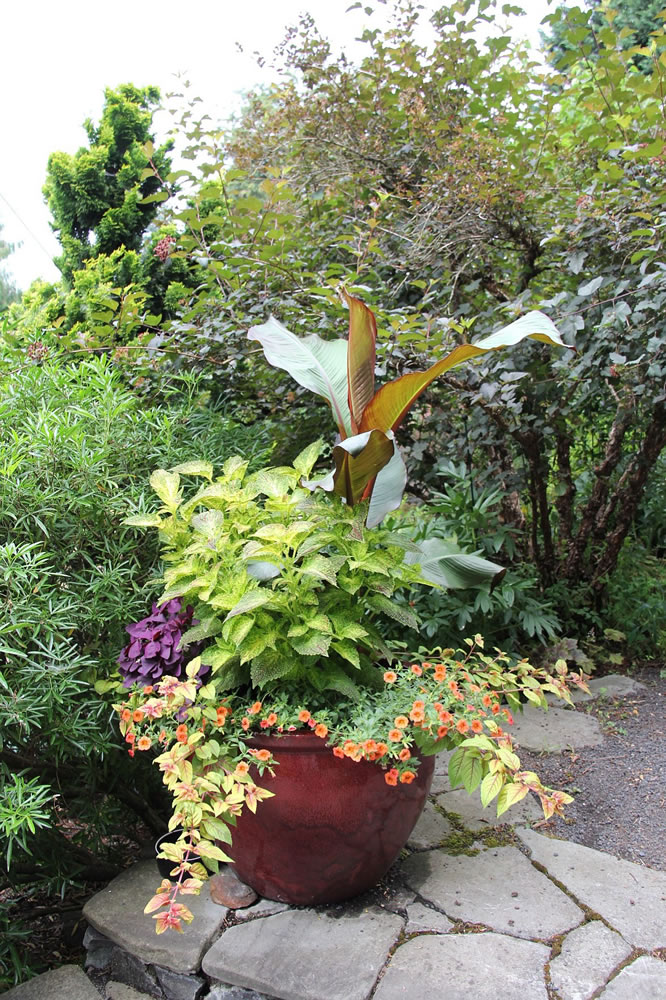Many novice gardeners are under the misconception that everything works out perfectly for gardeners who have more experience than they do. The reality is that longtime gardeners suffer from many of the same concerns as those of the neophyte gardener. I’m including myself when I say that gardeners have issues. The longer you garden, the more likely it is that you will have issues, too.
This year, for example, we have had little rain. Hot, sunny weather has begun to stretch into periods of intense heat lasting many days. The baking sun has surprised many of us by frying the tips of leaves on plants that have never suffered such exposure before. Shrubs and perennials that have not needed additional water since they became established in the garden are now showing the stress of arid conditions in gardens all over Southwest Washington.
This issue is exacerbated for me by the fact that I have so many plants in containers. I often place newly acquired shrubs and trees in large containers until I find the plant’s ideal permanent location. After my move last year, I left a collection of small trees and miniature conifers in outdoor planters with my neighbor John. All of these plants need to be monitored more closely than those planted out in the garden so now I have added my problem to my friend’s to-do list.
One of the most pressing garden issues to deal with in summer is whether to plant now or to hold off planting the trees, shrubs and perennials we have collected up to this point in time. If I plant now, it will be a challenge to water each plant conscientiously when they are dispersed throughout the garden. I have to consider whether or not these plants would have a better chance of survival if they were simply clustered together in the shade near a water source until temperatures subside.
This should be enough to convince us all to stop buying new plants this late in the season. Try telling that to the 400 participants of this year’s Hardy Plant Society Study Weekend. Every garden we visited turned us on to a new plant we had to have and at every nursery we visited, checkout lines grew longer. Gardeners simply cannot pass up what they think will be their last chance to own the latest, greatest plant.
The logical, unemotional reader is probably shaking his or her head at this self-induced dilemma. I agree. I often preach the mantra to water each newly planted purchase once a day for a week, twice a week for a month and then continue to water whenever the soil dries out in hot, sunny weather. This good garden rule might be difficult to follow in midsummer, especially if I never get the plants into the ground.
Two components
We are all faced with two major components that affect the issues we end up having with our own gardens. One is to understand the art of creating a garden and the other is understanding the science of gardening. No two of us approach the same garden situation exactly the same. We learn differently and we have diverse takes on creativity. Despite these differences, we all share the passion for what gardening gives us in return for our involvement.
This is why, despite any personal garden issues, I continue to immerse myself in the gardening experience. It’s fun to garden. I like the process. It’s always an adventure. Since I approach gardening as an artistic endeavor, my eyes are always open to the addition of a new feature plant for the garden. At the same time, I keep a lookout for plants that will complement those that are already in my garden.
For this reason, when I am shopping I often carry the plants I am going to buy around the nursery with me in case I happen to find another plant that sets off the flower color, highlights the leaf texture or in some way brings out the best features of the primary plant. I am aware that this compounds the original matter by adding more plants which will probably end up being lumped together with the others in a holding area, awaiting my decision to plant or not to plant this summer. I’ll be the first to admit that I have garden issues.



